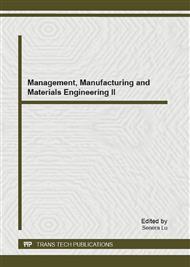[1]
Choi, Y., Kang, D., and Chae, H., and Kim, K.: An Enterprise Architecture Framework for Collaboration of Virtual Enterprise Chains, Int J Adv Manuf Tech, 2008, vol. 35, (11-12), pp.1065-1078.
DOI: 10.1007/s00170-006-0789-7
Google Scholar
[2]
Akkermans, H.A., Bogerd, P., and Yücesan, E., and van Wassenhove, L.N.: The Impact of ERP on Supply Chain Management: Exploratory Findings From a European Delphi Study, Eur J Oper Res, 2003, vol. 146, (2), pp.284-301.
DOI: 10.1016/s0377-2217(02)00550-7
Google Scholar
[3]
Cagliano, R., Caniato, F., and Spina, G.: The Linkage Between Supply Chain Integration and Manufacturing Improvement Programmes, International Journal of Operations & Production Management, 2006, vol. 26, (3), pp.282-299.
DOI: 10.1108/01443570610646201
Google Scholar
[4]
Grubic, T., and Fan, I.: Supply Chain Ontology: Review, Analysis and Synthesis, Computers in Industry Semantic Web Computing in Industry, 2010, vol. 61, (8), pp.776-786.
DOI: 10.1016/j.compind.2010.05.006
Google Scholar
[5]
Sprott, D.: Componentizing the Enterprise Application Packages, Communications of the ACM 43, 2000, vol. 43, (6), pp.63-69.
DOI: 10.1145/332051.332074
Google Scholar
[6]
Sowa, J.F.: Ontology, Metadata, and Semiotics, Conceptual Structures: Logical, Linguistic, and Computational Issues, Proceedings, 2000, vol. 1867, pp.55-81.
DOI: 10.1007/10722280_5
Google Scholar
[7]
Fu S C, Wang H F. The Supply Chain Automorphism: A Fundamental Structure for Accurate Forecast and Seamless Link: The 5th International Conference on Cooperation and Promotion of Information Resources in Science and Technology (COINFO'10)[Z]. Beijing, China. : Scientific Research Publishing, 2010, pp.328-334.
Google Scholar
[8]
Sherehiy, B., Karwowski, W., and Layer, J.K.: A Review of Enterprise Agility: Concepts, Frameworks, and Attributes, Int J Ind Ergonom, 2007, vol. 37, (5), pp.445-460.
DOI: 10.1016/j.ergon.2007.01.007
Google Scholar
[9]
Swafford, P.M., Ghosh, S., and Murthy, N.: Achieving Supply Chain Agility through It Integration and Flexibility, Int J Prod Econ, 2008, vol. 116, (2), pp.288-297.
DOI: 10.1016/j.ijpe.2008.09.002
Google Scholar
[10]
Meyer, J.W., and Rowan, B.: Institutionalized Organizations: Formal Structure as Myth and Ceremony, American Journal of Sociology, 1977, vol. 83, (2), pp.340-363.
DOI: 10.1086/226550
Google Scholar
[11]
DiMaggio, P.J., and Powell, W.W.: The Iron Cage Revisited: Institutional Isomorphism and Collective Rationality in Organizational Fields, American Sociological Review, 1983, vol. 48, (2), pp.147-160.
DOI: 10.2307/2095101
Google Scholar
[12]
Tolbert, P.S., and Zucker, L.G.: Institutional Sources of Change in the Formal Structure of Organizations: The Diffusion of Civil Service Reform, 1880-1935, Administrative Science Quarterly, 1983, vol. 28, (1), pp.22-39.
DOI: 10.2307/2392383
Google Scholar
[13]
Lai, K., Wong, C.W.Y., and Cheng, T.C.E.: Institutional Isomorphism and the Adoption of Information Technology for Supply Chain Management, Comput Ind, 2006, vol. 57, (1), pp.93-98.
DOI: 10.1016/j.compind.2005.05.002
Google Scholar
[14]
Aguilar-Saven, R.S.: Business Process Modelling: Review and Framework, Int J Prod Econ, 2004, vol. 90, (2), pp.129-149.
Google Scholar
[15]
Sen, A.: Metadata Management: Past, Present and Future, Decis Support Syst, 2004, vol. 37, (1), pp.151-173.
Google Scholar
[16]
Cingil, I., and Dogac, A.: An Architecture for Supply Chain Integration and Automation On the Internet, Distrib Parallel Dat, 2001, vol. 10, (1), pp.59-102.
Google Scholar
[17]
Staudt, M., Vaduva, A., and Vetterli, T.: Metadata Management and Data Warehousing, Swiss Federal Office of Professional Education and Technology under grant KTI-3979. 1, (2000).
Google Scholar
[18]
Chubb, J., Harizanov, V.S., and Morozov, A.S., Pingrey, S., and Ufferman, E.: Partial Automorphism Semigroups, Ann Pure Appl Logic, 2008, vol. 156, (2-3), pp.245-258.
DOI: 10.1016/j.apal.2008.06.016
Google Scholar


